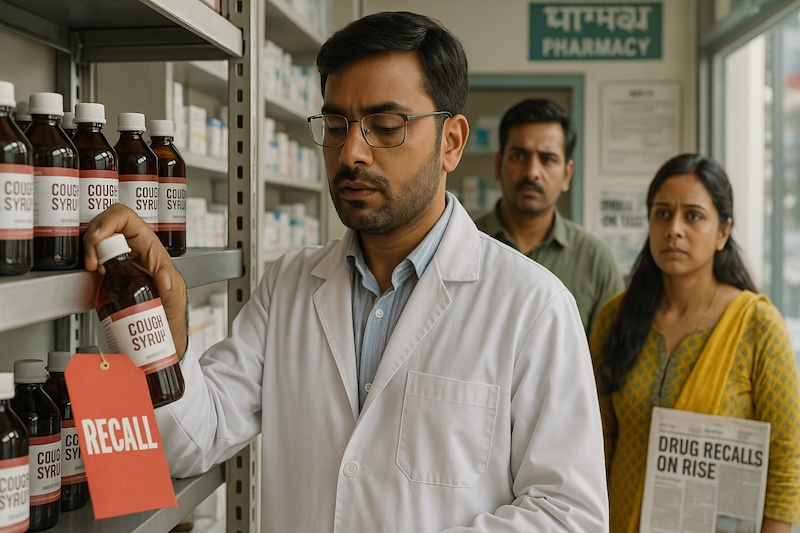Spurious Drugs in India: About 1 in 25 Samples Fail Quality Tests (2014–2025)

TL;DR: Spurious and substandard drugs remain a serious public health threat in India, with about 4% of tested medicines failing quality standards. Recent tragedies, including the deaths of children from contaminated cough syrup, highlight the human cost of regulatory gaps. These poor-quality medicines not only endanger lives but also erode trust in healthcare and burden families and hospitals.
Context
The recent deaths of 23 children due to cough syrup contaminated with diethylene glycol (DEG) have once again exposed the cracks in India’s drug manufacturing and quality control systems. This isn’t an isolated tragedy. In 2023, Indian-made syrups tainted with DEG were linked to the deaths of more than 60 children in The Gambia and several others in Uzbekistan.
Deaths caused by spurious and substandard drugs are not just regulatory failures; they are public health disasters. As India’s pharmaceutical industry continues to expand its global footprint, the consequences of poor-quality medicines travel farther and faster than ever before. In light of these tragedies, it becomes crucial to look at what the data tells us about the presence of spurious and substandard drugs in India.
Who compiles this data?
The data on the samples tested, the number of samples that are found spurious/substandard/adulterated, is compiled by various States/Union Territories Drugs Controllers and the Central Drugs Standard Control Organisation (CDSCO).
Where can I download clean & structured data on spurious/substandard drugs in India?
Clean, structured, and ready-to-use dataset on spurious/substandard drugs is available for download on Dataful. It provides insights on the number of samples tested, those found spurious/sub-standard/ adulterated and also on the action taken on the people responsible for such drugs.
Key Insights
The major categorisation of ‘not of standard’ quality reports could be as under:
- Spurious and Adulterated Drugs
- Grossly sub-standard drugs
- Minor Defects
- Nearly 1 in 25 drugs tested in India fail quality standards: Under the Drugs and Cosmetics Act, 1940 and its rules, both Central and State Governments, through their respective Drug Control organisations, are responsible for regulating the manufacture and sale of drugs and monitoring the movement of spurious medicines. Data from the past ten years (2014-15 to 2024-25) shows that, on average, about 3.7% of tested drug samples fall under the spurious or NSQ (Not of Standard Quality) category.
- A total of 4719 prosecutions were launched for manufacturing, sale and distribution of spurious/adulterated drugs.
- In case the sample is found to be Not of Standard Quality (NSQ)/ Spurious/Adulterated/Misbranded, actions are initiated as per provisions of the Drugs and Cosmetics Act, 1940. The data regarding drugs recalled after failing quality tests is not maintained centrally by CDSCO. However, data from states show that between 2019-20 and 2023-24, a total of 5759 batches were recalled for failing quality tests, with the highest batches recalled in 2023-24.
Why does it matter?
Every spurious or substandard medicine is a hidden danger, capable of worsening illnesses, causing permanent harm, or even taking lives. Beyond individual tragedies, spurious medicines erode faith in the healthcare system, increase medical costs, and strain hospitals treating preventable complications. In a country where millions rely on affordable medicines for survival, even a small fraction of faulty drugs can have devastating ripple effects.
Key Numbers
- Samples tested (in parentheses) and found NSQ/Spurious:
2014-15: 3785 (74199); 2019-20: 2696 (81329); 2024-25: 3349 (116323)
- Batches recalled after failing quality tests:
2019-20: 950; 2021-22: 1153; 2023-24: 1394 (Provisional)
- Prosecutions launched for manufacturing, distribution and sale of spurious and adulterated drugs;
2014-15: 152; 2019-20: 421; 2024-25: 961